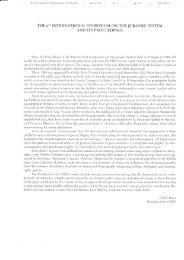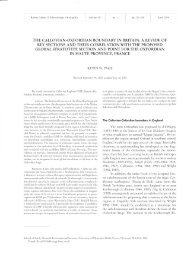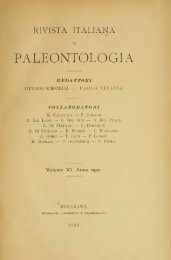ammonites, calcareous nannofossils and calpionellids
ammonites, calcareous nannofossils and calpionellids
ammonites, calcareous nannofossils and calpionellids
You also want an ePaper? Increase the reach of your titles
YUMPU automatically turns print PDFs into web optimized ePapers that Google loves.
Section I (Fig. 3) - The calpionellid assemblases rre<br />
very poor <strong>and</strong> the stalte of preservation is uroder;rte. Thc<br />
first occurrence of <strong>calpionellids</strong> is at 18.00 r.n <strong>and</strong> is represented<br />
by common <strong>and</strong> diversified species ol Crassicollaria.<br />
Just above, Remaniella sp. occurs in conconrit,rnce<br />
with the last occurrence ol Saccoconta. Ar 19.00 nr the<br />
bloom of Calpionella alpina Lorenz, isor.netric specinrens.<br />
is found. This event is used to identify the Tithoni:,rnl<br />
Berriasian boundary (Remane 1998; Oloriz et al. 1995;<br />
Caracuel et al. 2002). Just above, the FO of Retttaniella<br />
dur<strong>and</strong>delgai (Pop), confirn.rs the early Berrirrsian ase<br />
lGrùn & Blau 1997).<br />
Section II - Section II of Contr:rdir Diesi shou,s<br />
well preserved, diversified <strong>and</strong> ,rbundant calpionellid rrssemblases<br />
that allow the identification of several zones<br />
<strong>and</strong> subzones (Figs. 5, 6 <strong>and</strong> Pl. 3).<br />
The first occurrence of c:rlpionellids is found ,rt<br />
8.50 m fror.n the brrse of the sectior.r ,rnd it is represented<br />
by small Tirttinnopsella rernanei (Colom), Calpionella<br />
alpina Lorenz <strong>and</strong> Crassicollaria spp.. This assen.rblage<br />
identifies the Crassicollaria Zone (A Zone of Rern:rne<br />
1998 <strong>and</strong> Remartei Subzone of Grijn E: Blau 1997),<br />
which mark the base of the upper Tithonian. Fronr 8.90<br />
m, the asser.nbltrge becor.nes more irbundant <strong>and</strong> diversified<br />
with the appearirn ce of Crassicollaria úrezis Renrane<br />
(Pl. 3, fig. 3), Crassicollaria massutiniana (Colom) (Pl.<br />
3, fig. 4), Crassicollarìa intermeclia (Dur<strong>and</strong>-Delga) (Pl.<br />
3, fig. 1), Crassicollaria parvula Remane (Pl. 3, fig. 2);<br />
in this assen.rblage :rlso C. alpina, Tintinnopsella carpathica<br />
(Murgeanu & Filipescu) (Pl. 3, fig. 15) :rnd trirnsitional<br />
fornrs of C. alpina/Calpionella elliptica (Pl. 3, fig. 8)<br />
(Calpionella sp. in Catalano & Liguort 1971, Pl. 2, figs.<br />
1,1,, 12 <strong>and</strong> C. alpina holneomorph of C. elliptica in Remane<br />
1985, fig.6 <strong>and</strong> in Cecca et a1.200 1) are present.<br />
This assenrblage is referrrble to the Crassicollaria Zone<br />
(Intermedia Subzone) . At 9.50 n'ì, the genus Retnattiella,<br />
that marks the Catalanoi Subzone (Grùn & Blau 1997),<br />
first occurs. The finding of all three subzones of the<br />
Crassicollaria Zone records the presence of the entire<br />
upper Tithonian.<br />
The Tithonian/Berriasian boundarl, rvas recognized<br />
on the basis of the C. alpina isometric bloom (Pl. 3, fig. 9)<br />
(explosive extention of a sn.raller <strong>and</strong> spherical variety of<br />
C. alpina in Remane 1986). This event shows clearly the<br />
decrease of the Crassicollaria senus, which is represented<br />
only by Cr. paroula (Cecca, et al.2OO1). The first occurrence<br />
of Remaniella cf. dur<strong>and</strong>delgai (Pop) (Pl. 3, fig.<br />
7) is coeval with this bloom. On the whole, this chanse<br />
inside the assemblage identifies the base of the B Zone<br />
(Renrane 1998), th;rt corresponds to the base of the Calpionella<br />
Zone (Grùn 8r Blau 1997).Just above, Lorenziella<br />
dacica (Flhpescu 8{ Dr:rgirstan) occurs. The asserrrbl,rge<br />
does not change until 15.50 m, where the FO of Calpionellites<br />
darderi (Colom) (Pl. 3, figs. 16) nrarks the base<br />
of the Valanginian (Calpionellites Zone). Ct. darderi rs re-<br />
corded tosether wtth Praecalpionellites dadayi (Knauer)<br />
(Pl. 3, fig. 13), Calpionellopsis oblonga (Cadisch) (Pl. 3,<br />
fig. l0) <strong>and</strong> Praecalpionellites nturgeanui (Pop). At 23.50<br />
n, Calpionellìtes ntajor (Tre jo), r.n,rrker ol the Major Subzone,<br />
first occurs, indicating the upper part of the early<br />
Virlanuinian. Cirlpionellid assenrblarÌes referable to the<br />
middle <strong>and</strong> upper Berriasian ase were not found.<br />
Discussion <strong>and</strong> conclusion<br />
An interpretation of the Saccense Don.rain sedimentary<br />
evolution during the early Bathonian- late Valanginirrn<br />
tir-ne interv;rl was nrade possible by the new litho- <strong>and</strong><br />
biostrrrtigraphic d:rta collected at Mt. Maeaggiaro. In addition,<br />
the comparison of bioevents related to different<br />
fossil sroups lv,rs useful to critically assess the calibrated<br />
bios tr:rti graphic scher.n es alreardy existin g.<br />
One of thc r.r.rost striking features of this succession<br />
is the paraconformity between the bioclastic piatfon.r.r<br />
lirr.restone (Inici Fn.r., Sinemurian p.p.) <strong>and</strong> the overlying<br />
pelagic deposits, i.e. the Bositra limestone (lower<br />
Bathoni:rn-middle Oxfordi;rn). This pelaeic unit is followed<br />
by a carlcisiltitic limestorre (nriddle-upper Oxfordian),<br />
through ir shirrp discontinuity surfrrce nr:rrked by a<br />
thin, black stron.ratolitic crust. The sedimentation then<br />
evolves, thror-rch a stron.ratolitic level <strong>and</strong> a pebbly calcarenite<br />
(Kinrmerideian-Tithonian), into a nodular marly<br />
limestone (Tithonian). The nodular marly limestone<br />
is eradually replaced by a whitish, thinly-bedded limestone,<br />
the C:rlcari a Calpionelle of late Tithonian to late<br />
Vlllnqini:in rrge.<br />
In the lower part of the succession the biostratigraphic<br />
analysis was facilitated by the presence of rich<br />
amnronite assenrblages. An-rmonite distribution produced<br />
new biostratiuraphic elements indicating several biozones<br />
of the Bathonian-late Valaneinian tin.re interval. Callovian<br />
armrnonites (M. gracilis Zone, R. anceps Zone) are relatively<br />
rare, while Bathonran (2. zigzagZone, P progracilis<br />
Zone, H. retrocostdtum Zone), Oxfordian (P claromon-<br />
tattus Zone, P plicatilis Zone, G. transoersarium Zone, P.<br />
bifurcatws Zone, E. bimammaturn Zone), <strong>and</strong> early Kimn-reridsian<br />
(l . planula Zone, S. platynota Zone, P berbicbi<br />
Zone) an.rmonites are well represented. The occurrence<br />
ol Corongoceras spp. indicates the base of the upper Tithonian,<br />
whr\e Titbopeltoceras parasleabensis (Fallot &<br />
Ternrier) md Spiticeras spitiense (Blanford) indicate the<br />
lower Berriasian. Furthermore, common specimens of<br />
Olcostepbanu.r spp. at the top of the succession suggest<br />
:.r late V,rl;rnginian age.<br />
Biofacies analysis pointed out the occurrence of<br />
the following significant events:<br />
- the abundance of thin-shelled bivalves characterizes<br />
the Bathoniirn-Callovian interval <strong>and</strong> their disappearance<br />
at the base of the middle Oxfordian is coincident<br />
with a sharp discontinuity surface;
















